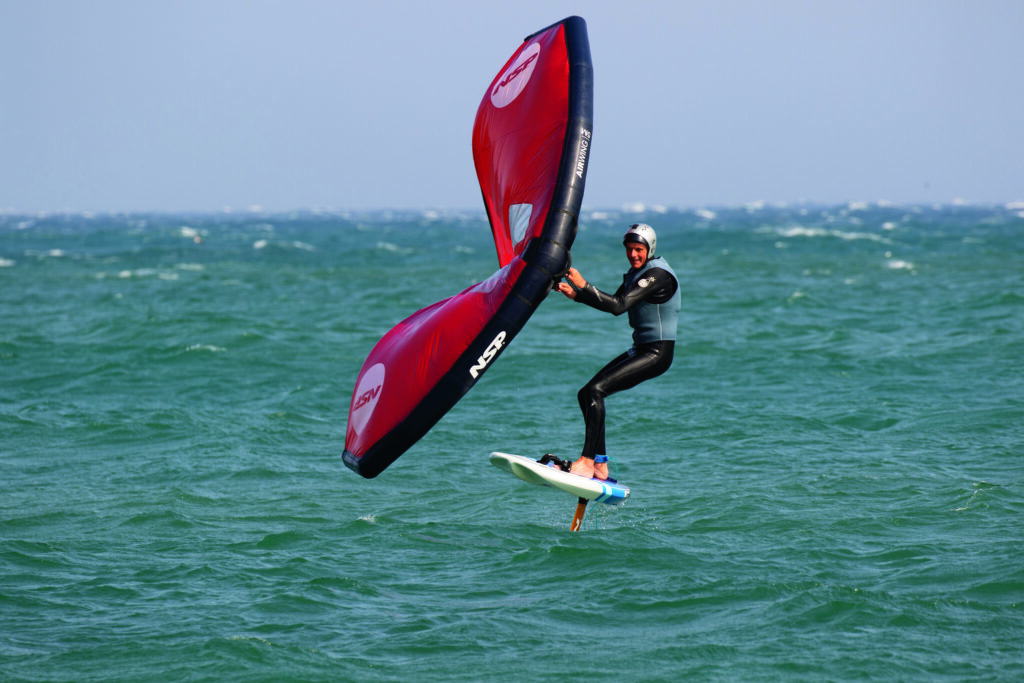Foil Boards are creating a hydrodynamic evolution revolutionizing virtually every aspect of water sports. Foiling has infiltrated windsurfing, kiting, prone and stand-up paddle surfing — and if you’ve had to do a double-take driving or walking past a human on a hovercraft in the bay, you’ve seen the latest adaptation, the e-foil. Here are three ways to get out on the water with a board:
Surf

Foiling in the surf took off over 15 years ago when legendary waterman Laird Hamilton was experimenting, first on a product called an air chair. He eventually mounted a foil to the bottom of a surfboard, which he skillfully rode on the 50-foot waves of Pehi (Jaws) on Maui. When footage of this appeared in the 2004 movie, Riding Giants, people paid attention. Soon, others began to mount foils on all types of surf craft. Stand-up paddle foiling and prone foiling began popping up at surf breaks all over the world. By swinging their arms and pumping their legs, these athletes create their own momentum to catch a wave, kick out and pump the board on to the next wave of their liking.
Wind

On the wind side, you need to look no further than the America’s Cup, where monohull boats that typically never go above 10 miles an hour are now reaching speeds of 60 miles per hour. On a smaller scale, windsurfing and kite surfing foils allowed high performance speed at lower wind speeds, as well as an escape from the pounding on the surface of the water, resulting in a smooth and quiet ride. Another new and complementary product to the foil to hit waterways around the world is the handheld wing/sail. Just two short years ago, Ken Winner of Duotone Kites began experimenting with a handheld wing that has just exploded on the water sports market. It allowed people to get foiling in very light winds without all the hassle of windsurfing equipment. The wing is extremely intuitive and much safer than kiting and kite foiling, and it’s called wingsurfing. It’s light years safer than kiting and more intuitive than windsurfing. Major kite companies are selling 20 wings for every kite and wind enthusiast are jumping on the wingboarding foil train. The secret is the lift of the wing. Once the wing achieves enough forward motion, it then generates enough lift that the board or boat is lifted off the water, escaping the drag caused by the wetted surface area. At that point, the craft accelerates and the board rides smoothly above the surface of the water.
E-Foil

For those who want to glide in style without the surf or sails to deal with, e-foiling is your best option. It is also the fastest and easiest way to learn to foil because it teaches the balance that is required to be stable when you are on foil. In 2013, Nick Leason — an engineer and avid surfer — came up with the idea for the e-foil, applying technology from smart phones, electric vehicles and even drones into a board that would let its rider fly above any body of water without needing to be propelled by wind or waves.
How to help:
Consider supporting one of these local nonprofits that urgently need support during the pandemic.
More from Better:
- The Best Places to Play Golf Throughout the Bay Area
- Kids Find Hope on the Water Through Rowing — Donate to Help and Double Your Impact Now
- Champions On the Field and Off: 10 Most Inspiring Athletes
Cort Larned, avid waterman and two-time world champion windsurfer, is currently living in the San Francisco Bay Area where he is co-owner of 101 Surfsports and is actively teaching e-foiling, among other watersports.
